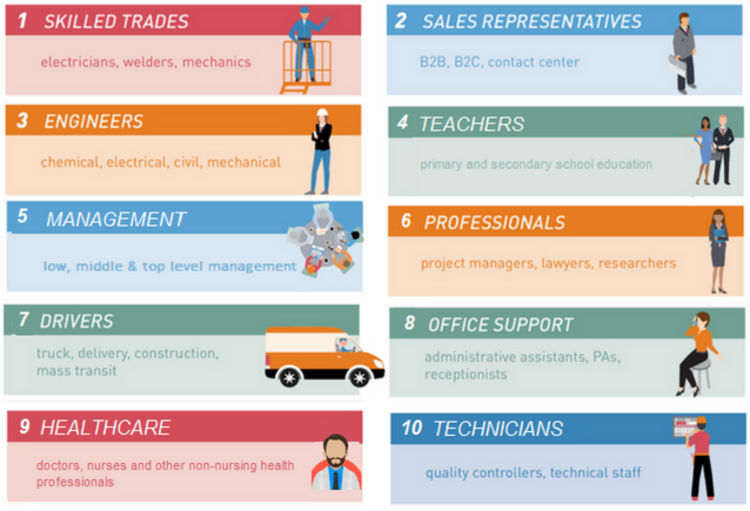Build, Buy, Burrow, Bridge
Unless you have been avoiding the internet and all media sources for the past few years, you will have heard (likely on multiple occasions) about the skills shortage affecting both Ireland and countries across the globe. And it’s impacting every industry, with organisations simply unable to find the people they need with the right blend of technical and soft skills.
As ManpowerGroup’s latest Talent Shortage report highlights, Engineers, Technicians, Management, and Professionals (project managers, lawyers and researchers) are among the top 10 most in-demand skills in Ireland. But what can organisations looking to recruit this specialist talent do to ensure that they are not negatively impacted by these shortages?
As the global leader in professional resourcing and workforce solutions, working with over 80% of the Fortune Global 500, we have a deep understanding of the most effective workforce strategies in the digital age. To help you build your specialist talent pipeline, here are the four key parts we believe organisations need to develop an effective talent strategy:
1. Build - Invest in learning and development to grow your talent pipeline
With specialist professionals becoming increasingly difficult to source in the market, many organisations are beginning to turn to building their own talent in-house. Over half of the organisations surveyed are investing in learning platforms and development tools to build their talent pipeline, up from just 20% in 2014. 64% of employers are upskilling people in hard skills through technical certifications, apprenticeships and programming courses. And 56% are investing to develop their employees’ soft skills.
But rather than selecting who goes forward for specific training based on a gut feeling, businesses must move towards making these decisions based on data: improved people analytics, psychometric assessment, predictive performance and AI can help employers to map their workforce and upskill their talent to areas where they require specialists.
Most importantly, this approach can also be very positive for the employee, encouraging them to stay with the organisation longer as they develop and progress in their career.
2. Buy – Go to external market to find the best talent that cannot be built in-house in the timeframe required
Sometimes the speed that you require for business critical projects to be delivered means that organisations just don’t have the time to upskill an existing member of staff into a new role. Instead, you need to deploy someone who already has the right capabilities to fill your skills gap.
In specialist markets such as IT and engineering where the talent is particularly hard to find, employers need to work harder to attract talent. This includes developing and showcasing a strong employee value proposition, a clear purpose for the organisation and an attractive culture. In the absence of this, employers should expect to be prepared to pay a premium with benefits, wages or other perks.
This is all the more important given how transparent workplaces are to today’s job seekers – and it’s becoming much harder to hide when your culture isn’t up to scratch.
3. Borrow – Cultivate communities of talent outside the organisation, including part-time, freelance, contract and temporary workers to complement existing skills
Businesses often require talents for a short-term project, perhaps as part of an IT infrastructure implementation or to support with a large-scale engineering project.
Traditionally, HR has focused on permanent employees, but with a greater number of workers choosing to work more flexibly, particularly in markets such as IT where contractors can often attract much higher salaries, total talent management solutions will be increasingly beneficial. Organisations must learn to cultivate communities of workers inside and outside of the company, tapping into the required talent in all its available forms.
4. Bridge – Help people move on and move up to new roles inside or outside the organisation
The final pillar of the talent strategy is helping people to move on and up to new roles – whether they are with your organisation or elsewhere. This is particularly important for roles which are becoming redundant within the organisation, and organisations should work to identify and nurture talent with transferable skill sets.
Done effectively, this approach will help the organisation to optimise the skills they have, and find alternative pathways for those whose skills no longer fit the business requirements.
Unfortunately it will not always be possible to move people into a new role within their existing organisation, and employers must ensure that they treat people with respect and dignity in helping them to transition smoothly, taking their skills to new roles in other businesses.
If you’d like to find out more about how Experis can help with your talent shortages, visit our Client Services section, or get in touch.
The post Build, Buy, Borrow and Bridge – how to solve the talent shortage in your organisation appeared first on ManpowerGroup.





